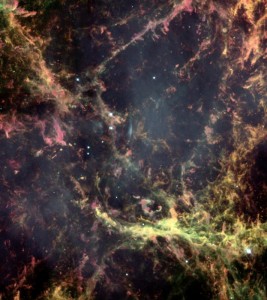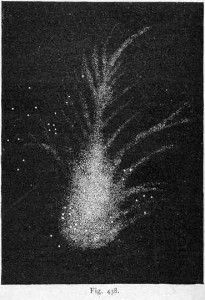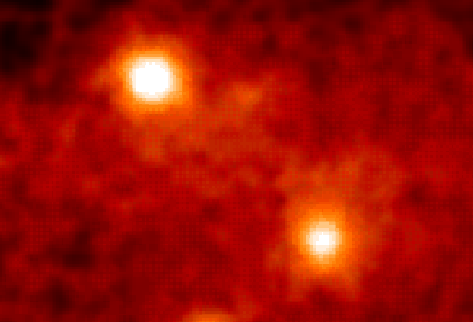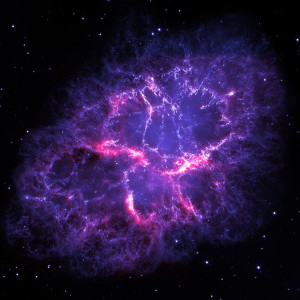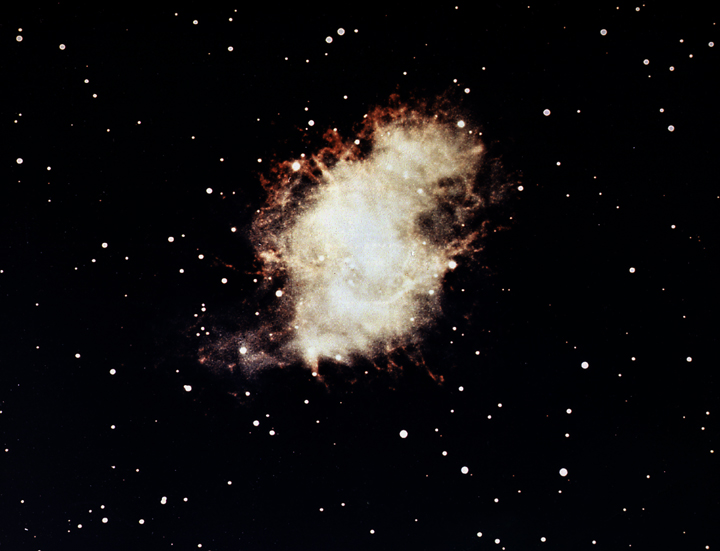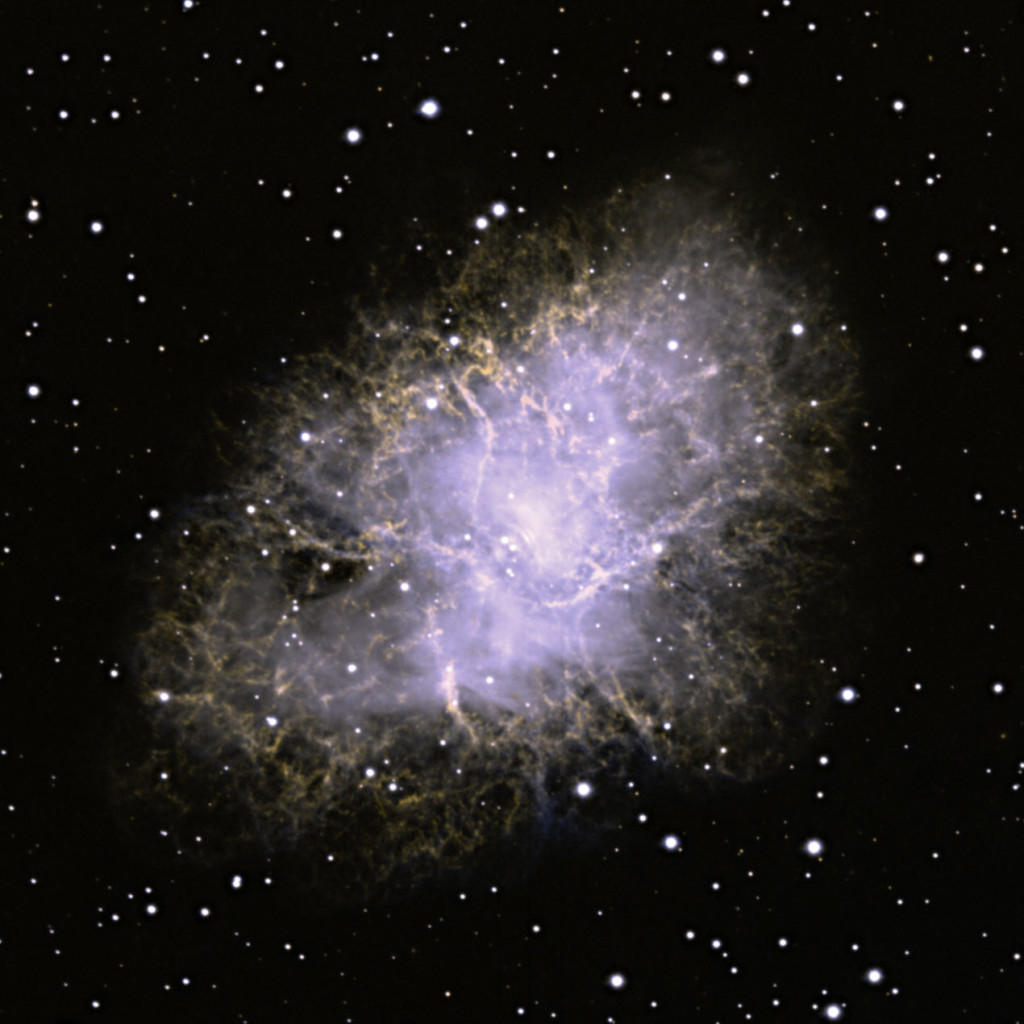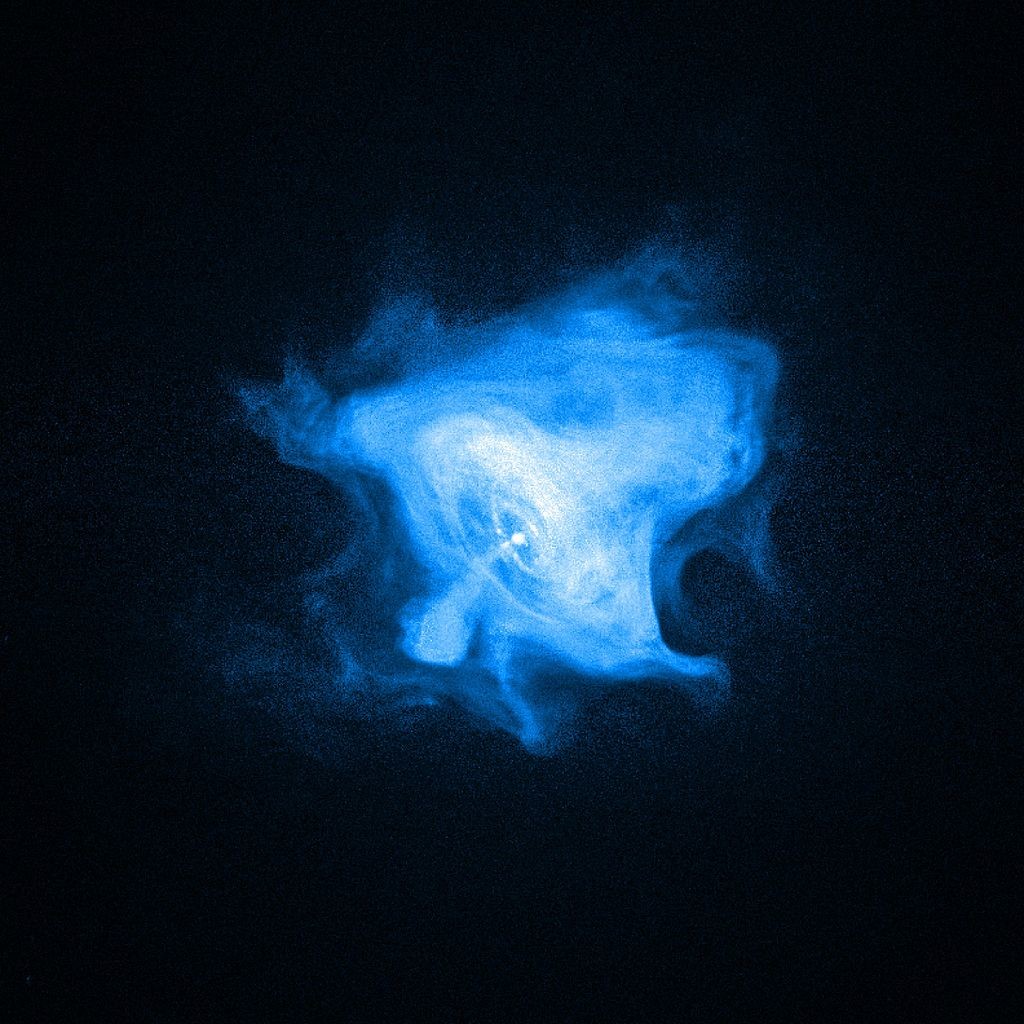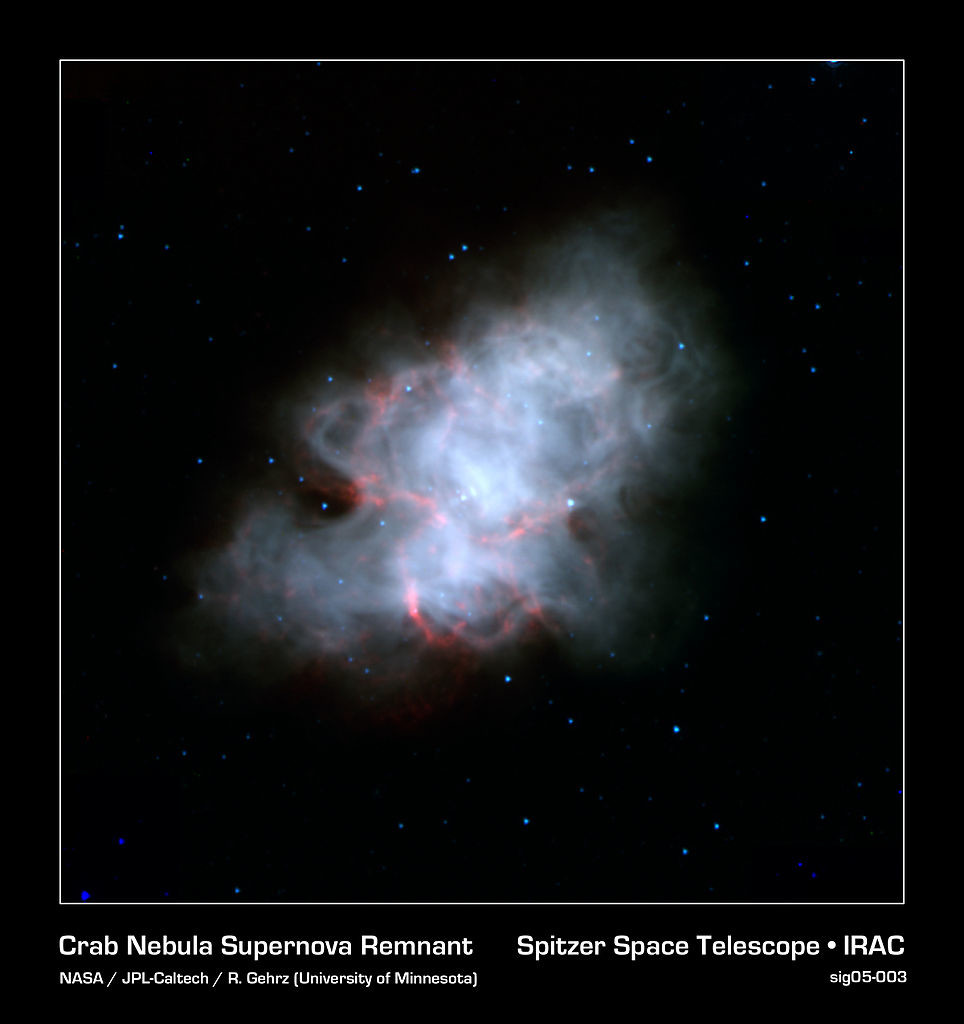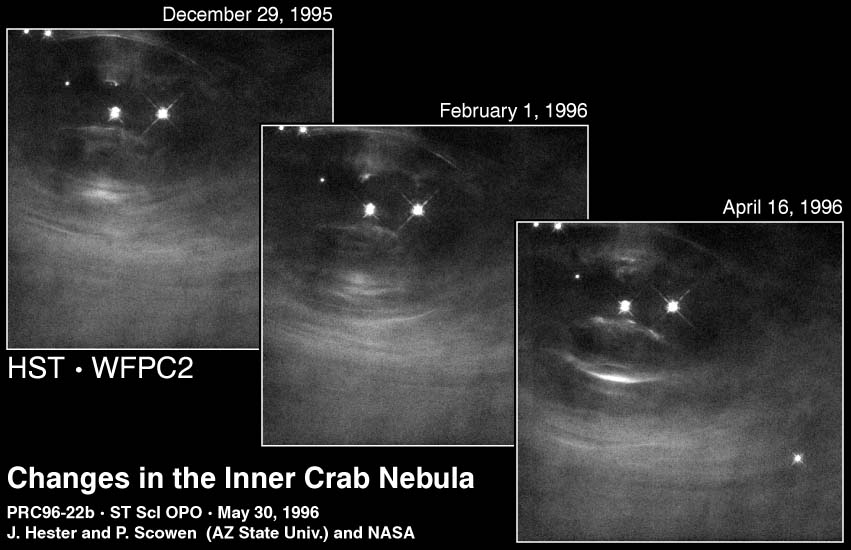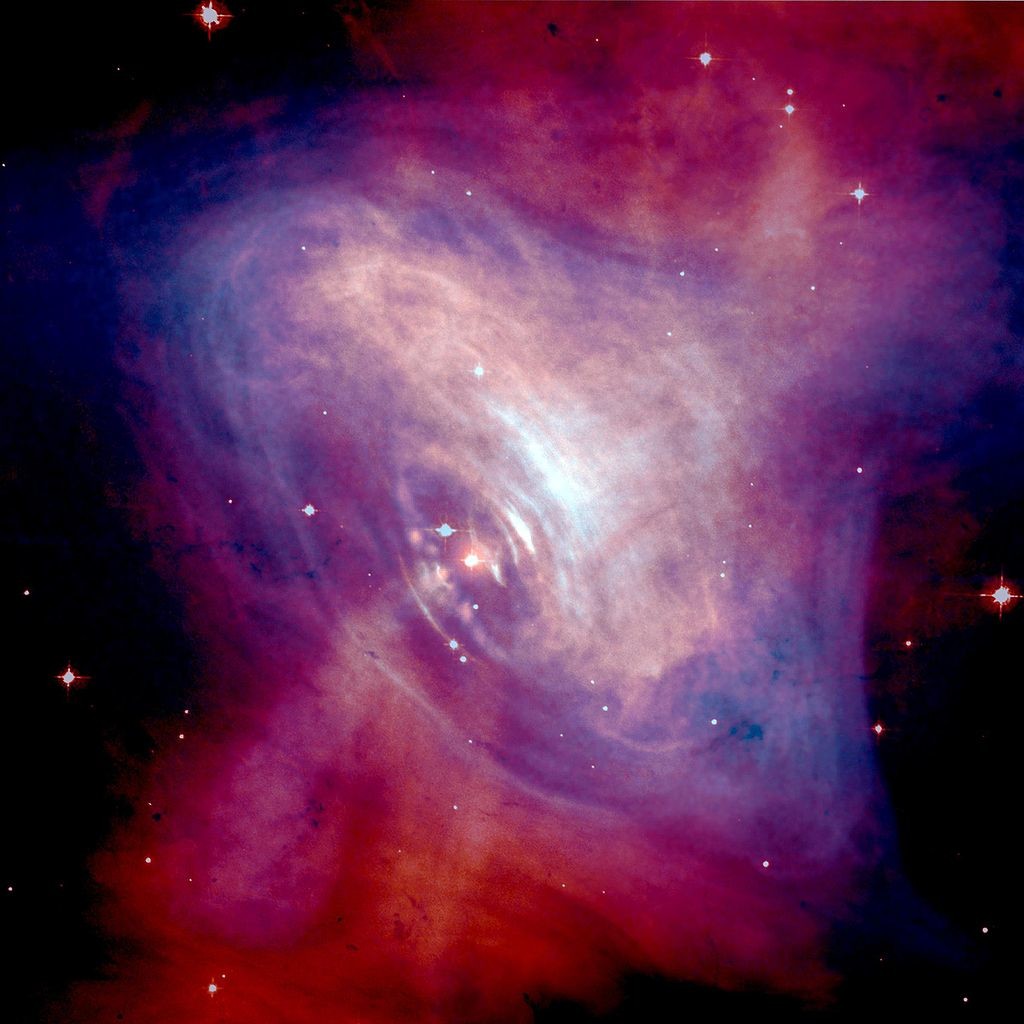Messier 1: Crab Nebula - Messier Objects (original) (raw)
Messier 1 (M1), also known as the Crab Nebula, Taurus A, or NGC 1952, is an expanding supernova remnant and pulsar wind nebula. It is located in the northern constellation Taurus, the Bull. The Crab Nebula has an apparent magnitude of 8.4 and can be seen with binoculars in good viewing conditions.
Messier 1 is the only supernova remnant listed in Messier’s catalogue and the most famous object of its kind in the night sky. The nebula has a total luminosity 75,000 times that of the Sun and lies at a distance of 6,500 light years from Earth.
The Crab Nebula is the result of a supernova explosion, SN 1054, that was observed by Chinese astronomers in 1054 AD. It was the first deep sky object to be associated with a historical supernova explosion.
Messier 1 is about 11 light years (3.4 parsecs) in diameter and keeps expanding at a rate of about 1,500 kilometres per second. The supernova remnant contains the Crab Pulsar, a rapidly rotating neutron star that spins at a rate of 30.2 times per second. The pulsar, also catalogued as PSR 0531+21, is the youngest one observed. It emits radiation in optical, radio, ultraviolet, X-ray and gamma ray wavelengths.
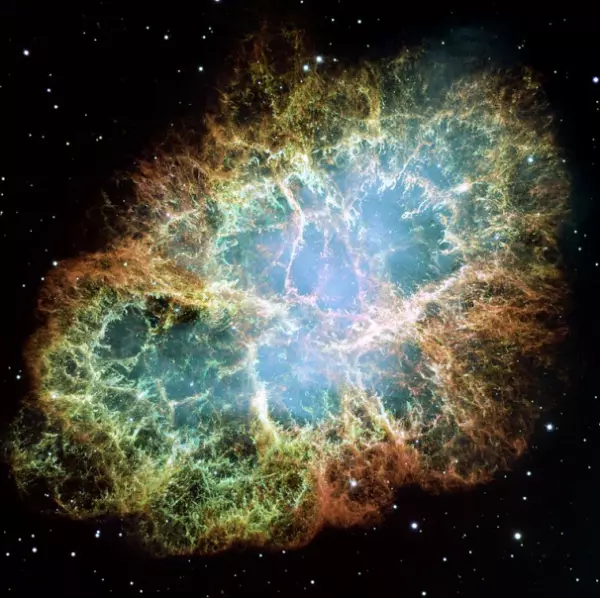
Messier 1 – The Crab Nebula. This is a mosaic image, one of the largest ever taken by NASA’s Hubble Space Telescope of the Crab Nebula, a six-light-year-wide expanding remnant of a star’s supernova event. Japanese and Chinese astronomers recorded this violent event nearly 1,000 years ago in 1054, as did, almost certainly, Native Americans. The orange filaments are the tattered remains of the star and consist mostly of hydrogen. The rapidly spinning neutron star embedded in the center of the nebula is the dynamo powering the nebula’s eerie interior bluish glow. The blue light comes from electrons whirling at nearly the speed of light around magnetic field lines from the neutron star. The neutron star, like a lighthouse, ejects twin beams of radiation that appear to pulse 30 times a second due to the neutron star’s rotation. A neutron star is the crushed ultra-dense core of the star. Image: NASA, ESA, J. Hester and A. Loll (Arizona State University)
As a radio source, M1 is catalogued as Taurus A and 3C 144. It was identified as a strong source of radio emission in 1949. X-ray emissions from the nebula were detected in April 1963 and the X-ray source was named Taurus X-1. M1 is the strongest persistent source of X-rays and gamma rays in the sky, with energies measuring above 30 kiloelectron volts (keV).
The Crab Nebula is part of the Perseus Arm of the Milky Way galaxy. Only three other supernovae have been seen in our galaxy since SN 1054.
Hubble Space Telescope image of filaments in the Crab Nebula (M1, NGC 1952). Credit: NASA and The Hubble Heritage Team (STScI/AURA)
The explosion of the progenitor star produced a large shell of filaments that has continued to expand ever since and will eventually disperse and disappear into the surrounding space.
The nebula’s filaments contain ionised gas which is responsible for the nebula’s glow. The electrons found in the gas move at speeds close to the speed of light, emitting synchotron radiation, which makes the nebula visible in radio wavelengths.
The filaments of the Crab Nebula are what is left of the progenitor star’s atmosphere and they mainly consist of ionised hydrogen and helium, along with other elements including oxygen, carbon, iron, nitrogen, sulfur and neon. The temperatures of the filaments are typically in the range from 11,000 to 18,000 K.
The Crab Nebula was discovered by the English astronomer John Bevis in 1731. Bevis added the object to his sky atlas Uranographia Britannica, which was completed in 1750 but never published.
Charles Messier discovered the nebula independently on August 28, 1758 while looking for a bright comet and entered it as the first object in his catalogue on September 12.
His entry read, “Nebula above the southern horn of Taurus, it doesn’t contain any star; it is a whitish light, elongated in the shape of a flame of a candle, discovered while observing the comet of 1758.”
Messier at first believed that the Crab Nebula was Halley’s Comet, which was predicted to return that year, but then noticed that the object was not moving.
Drawing of the Crab Nebula. Originally published in Observations on Some of the Nebulae, Philosophical Transactions of the Royal Society of London vol. 134 (1844). Image: William Parsons, 3rd Earl of Rosse
The discovery gave him the idea to compile a catalogue of objects that observers could easily confuse with comets because of their cloudy appearance.
It was the French astronomer and mathematician Alexis Clairaut who had predicted the return of Halley’s Comet in late 1758, saying it would likely appear in Taurus constellation, which was why Messier was searching for it in this area of the sky.
In the first publication of his catalogue, Messier credited himself for the discovery. John Bevis was eventually acknowledged years later, after he had sent a letter to Messier in June 1771.
M1 was named the Crab Nebula after William Parsons, the 3rd Earl of Rosse, made a drawing of the object in 1844.
Lord Rosse observed the nebula at Birr Castle in Ireland using a 36-inch telescope. He called it the Crab Nebula because it bore a resemblance to a crab in his drawing.
Rosse could not confirm the resemblance after observing the object in a 72-inch telescope in 1848, but the name stuck to this day nevertheless.
The first photograph of M1 was taken by Dr. Isaac Roberts in December 1892 using a 20-inch telescope.
LOCATION
Messier 1 lies near the southern horn of the celestial Bull. It is located 1 degree northwest of the bright star Zeta Tauri. The star can easily be found by first locating Aldebaran, the brightest star in Taurus, and then following the line of the V-shape that Aldebaran is part of, to Zeta Tauri. Aldebaran can be located by following the line formed by the three stars of Orion’s Belt. It is the first bright star that appears on that imaginary line.
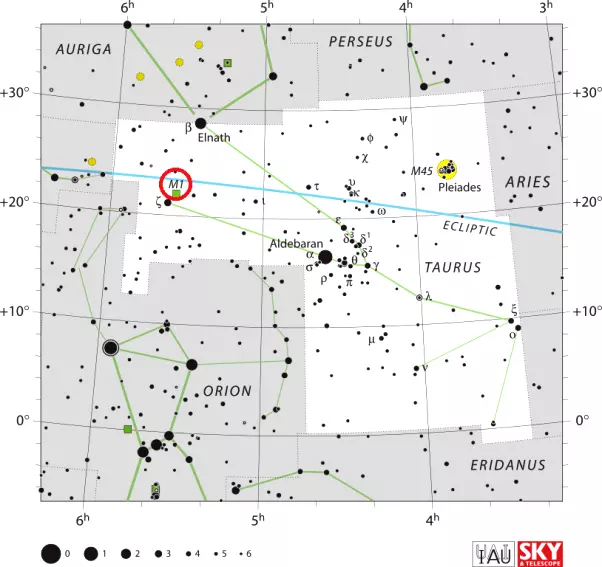
Location of the Crab Nebula (Messier 1) in Taurus constellation. Image: IAU and Sky & Telescope magazine (Roger Sinnott & Rick Fienberg)
Zeta Tauri forms a square with three much fainter stars. The Crab Nebula is located in the vicinity of the square and it appears as a faint patch of light in binoculars. The Crab Pulsar is 16th magnitude and can only be seen in larger telescopes (20 inches or so) in very good viewing conditions, with clear skies and no light pollution.
The Crab Nebula’s filaments and structure may become apparent in 16-inch telescopes under good conditions, while smaller telescopes, starting with 4-inch aperture, only reveal some detail in the shape of the remnant. In smaller instruments, M1 looks like a comet without a tail.
The best time to observe Messier 1 in the northern hemisphere is in late autumn and early winter, during the months of November, December, and January.
PULSAR
The Crab Pulsar is about 28 to 30 kilometres across and, as a result of its high spin rate, it emits pulses of optical, X-ray and radio radiation.
What if you could “see” in gamma-rays? If you could, these two spinning neutron stars or pulsars would be among the brightest objects in the sky. This computer processed image shows the Crab Nebula pulsar (below and right of center) and the Geminga pulsar (above and left of center) in the “light” of gamma-rays. Gamma-ray photons are more than 10,000 times more energetic than visible light photons and are blocked from the Earths’s surface by the atmosphere. This image was produced by the high energy gamma-ray telescope “EGRET” on board NASA’s orbiting Compton Observatory satellite. Image: NASA, Compton Gamma Ray Observatory.
It was one of the first pulsars to be discovered and it provided evidence for the theory that pulsars were formed by supernova events.
The progenitor star of Messier 1 was identified in 1942 by the German-American astronomer Rudolf Minkowski, who discovered that it had a very unusual optical spectrum.
In 1967, the region around the star was identified as one of the brightest gamma-ray sources in the night sky.
The mass of the neutron star is believed to be in the range from 1.4 to 2 solar masses.
The existence of the Crab Pulsar was first predicted by the Italian astrophysicist Franco Pacini in the 1960s to explain the nebula’s brightness.
The neutron star was observed for the first time in 1968.
As the remnant was associated with a historical supernova, it played a huge role in helping astronomers understand the nature of supernova remnants and made it possible for them to verify the pulsar’s basic properties, such as age, spin-down luminosity, and the orders of magnitude.
The Crab Pulsar is also catalogued as PSR 0531+21 or NP0532.
SUPERNOVA
Messier 1 was associated with the bright supernova SN 1054 in the early 20th century.
This image shows a composite view of the Crab Nebula as viewed by the Herschel Space Observatory and the Hubble Space Telescope. The image combines Hubble’s view of the nebula at visible wavelengths, obtained using three different filters sensitive to the emission from oxygen and sulphur ions and is shown here in blue. Herschel’s far-infrared image reveals the emission from dust in the nebula and is shown here in red. While studying the dust content of the Crab Nebula with Herschel, a team of astronomers have detected emission lines from argon hydride, a molecular ion containing the noble gas argon. This is the first detection of a noble-gas based compound in space. Image: ESA/Herschel/PACS/MESS Key Programme Supernova Remnant Team; NASA, ESA and Allison Loll/Jeff Hester (Arizona State University)
In 1921, American astronomer Carl Otto Lampland noticed changes in the nebula’s structure, which eventually led astronomers to conclude that M1 was the expanding remnant of the supernova recorded by Chinese astronomers on July 4, 1054 AD.
Chinese observers noted a “guest” star in the sky near the southern horn of Taurus.
Based on reports, SN 1054 was visible in the sky for 23 days. Analysis of historical records revealed that the supernova reached a peak magnitude of -7 and could be seen even in daylight.
It was the brightest object in the night sky, second only to the Moon, and it remained visible to the naked eye for 653 days after its discovery.
The supernova was also recorded by Arabic, Japanese, and Native American observers.
In the early 1920s, Swedish astronomer Knut Lundmark noted the nebula’s proximity to the historical supernova and, in 1928, American astronomer and cosmologist Edwin Hubble suggested that the nebula be associated to the exploding star.
However, as the nature of supernova events was not fully understood at the time, the suggestion remained confidential for several years, until the American astronomer Nicholas Mayall demonstrated that M1 was indeed the expanding remnant of SN 1054.
The progenitor star likely had a mass of between 9 and 11 solar masses.
The existence of the Crab Pulsar indicates that the nebula formed in a core-collapse supernova, one that occurs when a massive star runs out of fuel and collapses in on itself.
SN 1054 has the variable star designation CM Tauri.
FACTS
| Object: Nebula |
|---|
| Type: Supernova remnant |
| Designations: Messier 1, M1, Crab Nebula, NGC 1952, Sharpless 244, LBN 833, 3C 144 |
| Features: Optical pulsar |
| Constellation: Taurus |
| Right ascension: 05h 34m 31.94s |
| Declination: +22°00’52.2” |
| Distance: 6,500 light years (2 kiloparsecs) |
| Apparent magnitude: +8.4 |
| Absolute magnitude: -3.1 |
| Apparent dimensions: 420″ × 290” (6×4 arc minutes) |
| Radius: 5.5 light years (1.7 parsecs) |
IMAGES
This is the Crab Nebula in various energy bands, including a hard X-ray image from the HEFT data taken during its 2005 observation run. The angular resolution of HEFT is about 1.5′. Each image is 6′ wide. Image: NASA, CM Hubert Chen, Fiona A. Harrison, Principal Investigator, Caltech Charles J. Hailey, Columbia Principal, Columbia, Finn E. Christensen, DSRI Principal, DSRI, William W. Craig, Optics Scientist, LLNL, Stephen M. Schindler, Project Manager, Caltech
Crab Nebula in visible light taken by the Hale Observatory optical telescope in 1959. Credit: NASA Marshall Space Flight Center (NASA-MSFC)
The Crab Nebula (Messier 1) is a well-known supernova remnant (the remains from massive star whose life ended in a massive explosion). This false-color image of the Crab Nebula was taken at the Vatican Observatory on Mount Graham using Sloan u’, g’, and r’ filters. The yellow filaments on the outside of the remnant are primarily ionized hydrogen gas and show up in both the u’ and r’ filters. The gas in the interior of the nebula is heated by the neutron star left by the explosion and its glowing light is visible in all the filters. While the neutron star itself is too faint to be see in the visible, the glowing disk of gas and debris that surround it also shows up quite clearly in the g’ filter (blue-white colors). One of the jets thrown off by the accreting neutron star is also partially visible in the g’ filter to the lower-left of the accretion disk. Image: Jjstott at wikipedia.org
In the Crab Nebula, a rapidly rotating neutron star, or pulsar (white dot near the center), powers the dramatic activity seen by Chandra. The inner X-ray ring is thought to be a shock wave that marks the boundary between the surrounding nebula and the flow of matter and antimatter particles from the pulsar. Energetic particles move outward to brighten the outer ring and produce an extended X-ray glow. The jets perpendicular to the ring are due to matter and antimatter particles spewing out from the poles of the pulsar. The fingers, loops and bays visible on the outer boundary of the nebula are likely caused by confinement of the high-energy particles by magnetic forces. Image: Chandra X-ray Observatory, Smithsonian Institution, NASA/CXC/SAO/F.Seward et al.
This view of the supernova remnant obtained by the Spitzer Space Telescope shows the infrared view of this complex object. The blue-white region traces the cloud of energetic electrons trapped within the star’s magnetic field, emitting so-called “synchrotron” radiation. The red features follow the well-known filamentary structures that permeate this nebula. Though they are known to contain hot gasses, their exact nature is still a mystery that astronomers are examining.
The energetic cloud of electrons are driven by a rapidly rotating neutron star, or pulsar, at its core. The nebula is about 6,500 light-years away from the Earth, and is 5 light-years across.
This false-color image presents images from Spitzer’s Infrared Array Camera (IRAC) at 3.6 (blue), 4.5 (green), and 8.0 (red) microns. Image: NASA/JPL-Caltech/R. Gehrz (University of Minnesota)
Hubble Space Telescope observations of features very close to the Crab Pulsar, changing over time. Image: NASA
A composite image of the Crab Nebula showing the X-ray (blue), and optical (red) images superimposed. The size of the X-ray image is smaller because the higher energy X-ray emitting electrons radiate away their energy more quickly than the lower energy optically emitting electrons as they move. Optical: NASA/HST/ASU/J. Hester et al. X-Ray: NASA/CXC/ASU/J. Hester et al.
